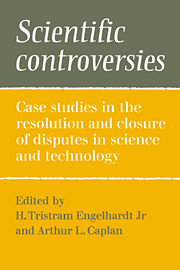 Scientific Controversies
Scientific Controversies Book contents
- Frontmatter
- Contents
- Preface
- List of contributors
- Introduction: Patterns of controversy and closure: the interplay of knowledge, values, and political forces
- PART I THEORETICAL PERSPECTIVES
- PART II CONTEMPORARY CASE STUDIES
- 12 Resolution of the Laetrile controversy: past attempts and future prospects
- 13 Federal regulation of Laetrile
- 14 Quasi libertarianism and the Laetrile controversy
- 15 Judicial deflection of scientific questions: pushing the Laetrile controversy toward medical closure
- 16 Politics, science, and the problem of psychiatric nomenclature: a case study of the American Psychiatric Association referendum on homosexuality
- 17 The diagnostic status of homosexuality in DSM-III: a reformulation of the issues
- 18 On arriving at the American Psychiatric Association decision on homosexuality
- 19 Values in the debate over workplace safety and health: the rancorous rhetoric about regulation
- 20 The successful experiment that failed
- 21 The power of efficiency: balancing benefits and costs in regulating occupational exposure to toxic substances
- 22 Closure in occupational safety and health: the benzene and cotton dust decisions
- 23 Nuclear fear: a history and an experiment
- 24 Closure and controversy: Three Mile Island
- 25 Understanding the nuclear power controversy
- PART III CONTROVERSY, CLOSURE, AND THE PUBLIC
- Author index
- Subject index
25 - Understanding the nuclear power controversy
Published online by Cambridge University Press: 03 February 2010
- Frontmatter
- Contents
- Preface
- List of contributors
- Introduction: Patterns of controversy and closure: the interplay of knowledge, values, and political forces
- PART I THEORETICAL PERSPECTIVES
- PART II CONTEMPORARY CASE STUDIES
- 12 Resolution of the Laetrile controversy: past attempts and future prospects
- 13 Federal regulation of Laetrile
- 14 Quasi libertarianism and the Laetrile controversy
- 15 Judicial deflection of scientific questions: pushing the Laetrile controversy toward medical closure
- 16 Politics, science, and the problem of psychiatric nomenclature: a case study of the American Psychiatric Association referendum on homosexuality
- 17 The diagnostic status of homosexuality in DSM-III: a reformulation of the issues
- 18 On arriving at the American Psychiatric Association decision on homosexuality
- 19 Values in the debate over workplace safety and health: the rancorous rhetoric about regulation
- 20 The successful experiment that failed
- 21 The power of efficiency: balancing benefits and costs in regulating occupational exposure to toxic substances
- 22 Closure in occupational safety and health: the benzene and cotton dust decisions
- 23 Nuclear fear: a history and an experiment
- 24 Closure and controversy: Three Mile Island
- 25 Understanding the nuclear power controversy
- PART III CONTROVERSY, CLOSURE, AND THE PUBLIC
- Author index
- Subject index
Summary
The nuclear power controversy in the United States is not very visible these days, but this is not because it has been resolved. The industry is still there, along with its effective lobbying organizations, such as the Atomic Industrial Forum, and so are the vigilant antinuclear watchdog groups, such as the Union of Concerned Scientists. They still descend upon the Nuclear Regulatory Commission (NRC) every time a new safety standard is proposed and they still slug it out in the courts over each new operating license. But lately these battles have failed to arouse the public or attract the news media to the extent that they did just a few years ago. Nuclear power's proven potential – to electrify public controversy – is still there, to be sure, but the controversy is in abeyance and it may remain so for some time to come.
This waning of public concern over an issue that so exercised us only yesterday is a remarkable phenomenon, for the technological risks that focused the controversy in the past – the risk of accidents and careless regulatory oversight, the risk of proliferation of nuclear weapons, and the risks to future generations from the accumulation of radioactive waste – have not changed significantly. The accident at Three Mile Island resulted in some changes in operating and regulatory procedures aimed at improving safety, but any reassuring effects of these changes are offset by other events. The Republican administration of President Reagan is pledged to help the nuclear industry and especially to relax and speed up licensing procedures.
- Type
- Chapter
- Information
- Scientific ControversiesCase Studies in the Resolution and Closure of Disputes in Science and Technology, pp. 567 - 582Publisher: Cambridge University PressPrint publication year: 1987
- 7
- Cited by


